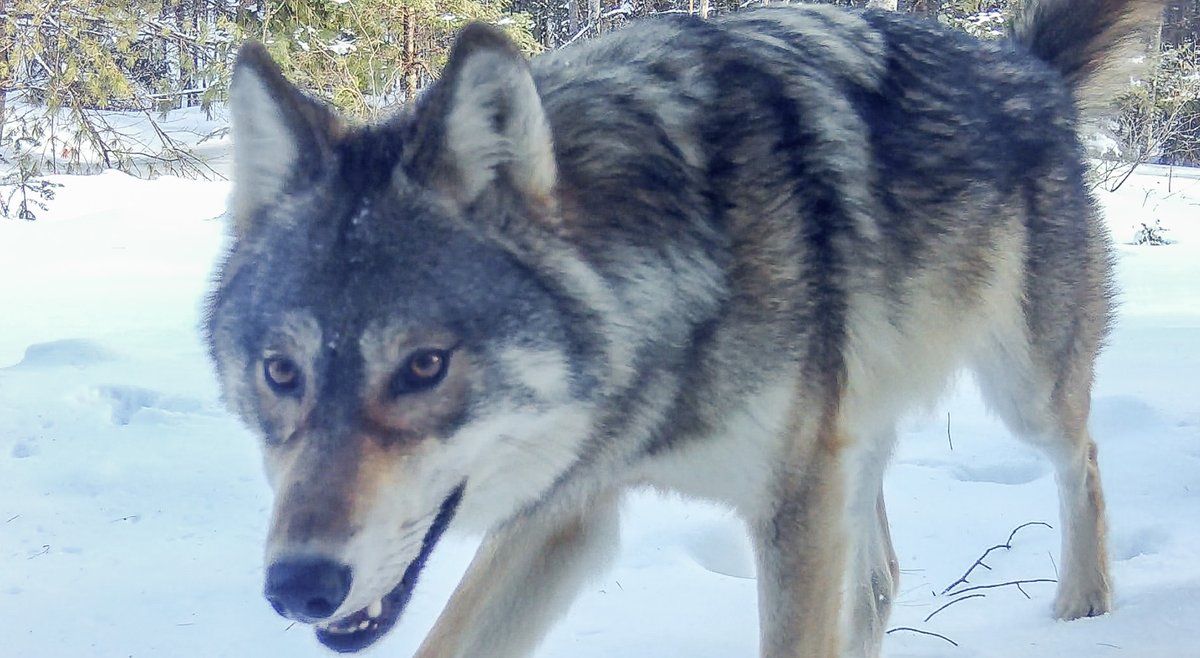We recently unraveled a perplexing mystery. This spring, we collared a female wolf in the Clearcut Pack territory. The wolf was clearly not, based on her appearance, one of the 3 Clearcut Pack members. But she has remained in the Clearcut Pack territory since we collared her. 

This left us a bit confused as to what was going on. If the female was a lone wolf, we would not be surprised if she lingered for a while before moving on but her movements were as if she were part of the pack…and we had good evidence to suggest she wasn't. 

Just recently, we started intensively reviewing all of our trail camera footage from this winter…and there is a ton of footage to go through and it is a long process. But this trail camera footage helped us piece it all together.
The young female we collared (Wolf B6T) had very distinctive facial markings, including a prominent black dash below her left eye. As we went through our footage, we realized she was the subordinate wolf of the Bluebird Lake Pack...






...which was only 3 wolves this past winter (Wolf B6T and her parents—Wolves P0C and P3S, the breeding pair).
And this is where things start to get interesting.
And this is where things start to get interesting.
In January, both of B6T’s parents were killed by other wolves within a 1 week period. We suspect one or both of her parents were killed by the Clearcut Pack—the pack that took over the Bluebird Lake Pack territory in January. 

After the breeding pair was killed, we had assumed that the 3rd wolf of the Bluebird Lake Pack (who we now refer to as B6T) was also killed or that it had become a lone wolf and left the area. Turns out, that wasn’t the case.
Instead, trail cameras show that this 3rd wolf (B6T) lingered around the former Bluebird territory the rest of the winter. We have numerous observations of B6T during February, March, and April in the area. But more interestingly, is that she was not alone in most videos. 

Indeed, B6T was traveling with an old grizzled looking male. As we examined and studied the male’s appearance, we kept thinking that he seemed to look familiar, as if we had seen him somewhere else before. We started sifting through footage and then it hit us.




This old grizzled male looked like the breeding male of the Clearcut Pack. We then started reviewing footage of Clearcut and confirmed it was indeed the breeding male based on a clear scar on the wolf’s left eye and a distinctive black splotch on his right cheek (see pics).




But what was this male, who already had a mate and pack, doing with this young female? Or better yet, what was this female doing with a male who likely helped kill her parents just a short while ago?
Ultimately, we don’t know.
Ultimately, we don’t know.

We had many videos of Clearcut this winter and B6T was not in them. Yet, she seems to be staying in the Clearcut territory as if she were a pack member. Maybe she has actually become a member recently, or perhaps the pack tolerates her given her relationship w/ the breeding male?
We captured a video in late February at night where we are pretty sure the Clearcut breeding male mounted B6T but she shirked his advances.
This observation suggests that the male might have been acting a bit promiscuous and hoping to have a mistress (the male mated with the breeding female of the Clearcut Pack, who gave birth this spring). 

Of course, trail camera footage provides brief snippets of insight into the social happenings of wolves. And so we have to try and take these tiny, little puzzle pieces and somehow arrange them in an attempt to make sense of the larger picture.
In the end, we don’t know why B6T is lingering around, what her relationship is with the Clearcut wolves, or if she will continue to stay in the territory. But at least figured out who B6T is, where she came from, and what she has been doing since her parents were killed.
And we suspect we will continue to unravel things as we continue following B6T and the Clearcut Pack.
• • •
Missing some Tweet in this thread? You can try to
force a refresh















